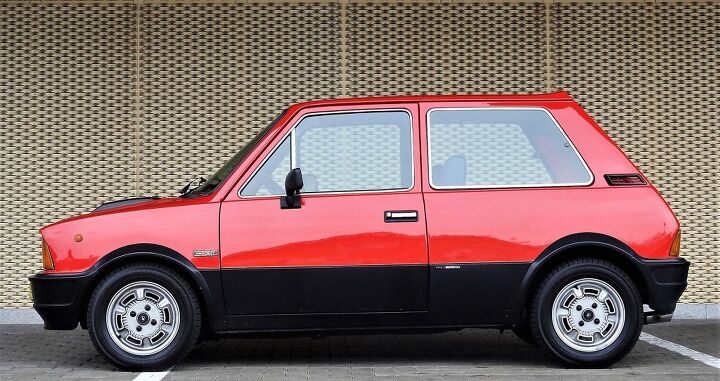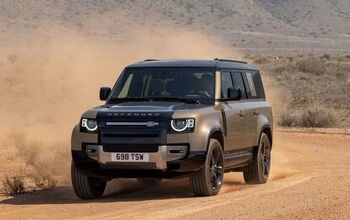Rare Rides: The 1978 Innocenti Mini Is Both De Tomaso and Bertone

Rare Rides returns again to De Tomaso, shortly after it covered the obscure Guarà Barchetta. This time, the subject vehicle is a British-designed Mini, rebodied by Bertone, then sported up by De Tomaso. Quite a pedigree.
Presenting the 1978 Innocenti Mini De Tomaso:
The Innocenti brand was founded in 1947 and made its name producing various models of Lambretta scooters in Milan. In an effort to expand the company’s horizons, it ventured into car production for the first time in 1961, receiving various licenses from British Motor Corporation (BMC), the company which would later become British Leyland. Innocenti built Minis, Allegros, and Austin-Healeys, all with Italian flair.
Innocenti vehicles were popular, and by the early Seventies domestic sales trailed only the massive Fiat. BMC was impressed with the company’s efforts, so much so that it bought Innocenti outright in 1972. All was well!
Well, not really. A few (three) years later, BMC went bust and was taken over by the government in a fine moment for capitalism England. Prime Minister Wilson was not interested in Innocenti, so the government arranged a sale to interested buyer Alejandro De Tomaso.
Innocenti built its Mini 90 and 120 models starting in 1974, while still under BMC ownership. Bertone handled the styling, though engines stayed British. De Tomaso wanted more, however, and ordered his people to develop a new version. First shown at the Turin Auto Show in 1976, the new hot hatch from Innocenti began production in 1977. Staid chrome bumpers disappeared in favor of aggressive plastic ones and an additional body kit. There was also a hood scoop, a new mesh grille, and specially-designed alloy wheels.
The De Tomaso carried a top-spec 1.3-liter inline-four from the Mini 120, with the power figure bumped from 65 to 71 horses. Said figure increased for the 1978 model year, to a raucous 74 hp. The transmission was the same (and only) one used in all Innocenti Minis: a four-speed manual.
Limited in production, Innocenti kept building Minis mostly unchanged through 1982. That year, De Tomaso’s license arrangement with BL concluded its tenure, and the British giant was not interested in signing new paperwork. De Tomaso no longer had an engine source, and sources for parts were slowing down, as well. After some engineering work, Innocenti continued producing Minis with a few cosmetic changes and brand new three-cylinder Daihatsu engines.
Throughout the early Eighties, Innocenti continued to revise the Mini while adding more parts from the Daihatsu Charade. In ’84, the model was renamed Minitre, and production of the rebodied Mini continued through 1993. During that decade, Innocenti continued to build cars; most were rebadge jobs for Europe, and some were the Chrysler TC by Maserati for Americans. The company closed up during 1996.
Today’s Rare Ride is the more powerful 1978 version of the De Tomaso, slathered in stunning red and black. With about 59,000 miles on the odometer, it’s presently for sale in Switzerland and asks $24,000.
[Images: seller]

Interested in lots of cars and their various historical contexts. Started writing articles for TTAC in late 2016, when my first posts were QOTDs. From there I started a few new series like Rare Rides, Buy/Drive/Burn, Abandoned History, and most recently Rare Rides Icons. Operating from a home base in Cincinnati, Ohio, a relative auto journalist dead zone. Many of my articles are prompted by something I'll see on social media that sparks my interest and causes me to research. Finding articles and information from the early days of the internet and beyond that covers the little details lost to time: trim packages, color and wheel choices, interior fabrics. Beyond those, I'm fascinated by automotive industry experiments, both failures and successes. Lately I've taken an interest in AI, and generating "what if" type images for car models long dead. Reincarnating a modern Toyota Paseo, Lincoln Mark IX, or Isuzu Trooper through a text prompt is fun. Fun to post them on Twitter too, and watch people overreact. To that end, the social media I use most is Twitter, @CoreyLewis86. I also contribute pieces for Forbes Wheels and Forbes Home.
More by Corey Lewis
Latest Car Reviews
Read moreLatest Product Reviews
Read moreRecent Comments
- 3-On-The-Tree My experience with turbos is that they don’t give good mpg.
- GregLocock They will unless you don't let them. Every car manufacturing country around the world protects their local manufacturers by a mixture of legal and quasi legal measures. The exception was Australia which used to be able to design and manufacture every component in a car (slight exaggeration) and did so for many years protected by local design rules and enormous tariffs. In a fit of ideological purity the tariffs were removed and the industry went down the plughole, as predicted. This was followed by the precision machine shops who made the tooling, and then the aircraft maintenance business went because the machine shops were closed. Also of course many of the other suppliers closed.The Chinese have the following advantagesSlave laborCheap electricityZero respect for IPLong term planning
- MaintenanceCosts Yes, and our response is making it worse.In the rest of the world, all legacy brands are soon going to be what Volvo is today: a friendly Western name on products built more cheaply in China or in companies that are competing with China from the bottom on the cost side (Vietnam, India, etc.) This is already more or less the case in the Chinese market, will soon be the case in other Asian markets, and is eventually coming to the EU market.We are going to try to resist in the US market with politicians' crack - that is, tariffs. Economists don't really disagree on tariffs anymore. Their effect is to depress overall economic activity while sharply raising consumer prices in the tariff-imposing jurisdiction.The effect will be that we will mostly drive U.S.-built cars, but they will be inferior to those built in the rest of the world and will cost 3x-4x as much. Are you ready for your BMW X5 to be three versions old and cost $200k? Because on the current path that is what's coming. It may be overpriced crap that can't be sold in any other world market, but, hey, it was built in South Carolina.The right way to resist would be to try to form our own alliances with the low-cost producers, in which we open our markets to them while requiring adherence to basic labor and environmental standards. But Uncle Joe isn't quite ready to sign that kind of trade agreement, while the orange guy just wants to tell those countries to GFY and hitch up with China if they want a friend.
- CEastwood Thy won't get recruits who want to become police officers . They'll get nuts who want to become The Green Hornet .
- 1995 SC I stand by my assessment that Toyota put a bunch of "seasoned citizens" that cared not one iota about cars, asked them what they wanted and built it. This was the result. This thing makes a Honda Crosstour or whatever it was look like a Jag E type by comparison.








































Comments
Join the conversation
What was it with Italian cars of this era having the absolute minimum possible amount of dashboard? No intrusive consoles here. No room for the stuff we take for granted in modern cars either. Want a heater, or God forbid air conditioning? Optional extras, we'll bolt 'em in under the dashboard.
Fun fact: in its later years, Innocenti sold the actual Daihatsu Charade as an Innocenti, including in Canada. The combination of a three-cylinder engine and a car that had grown a fair bit wasn't a great one. Car & Driver tested one, puzzled over "the case of the missing fuel economy," and concluded "it may be rough, but at least it's slow."